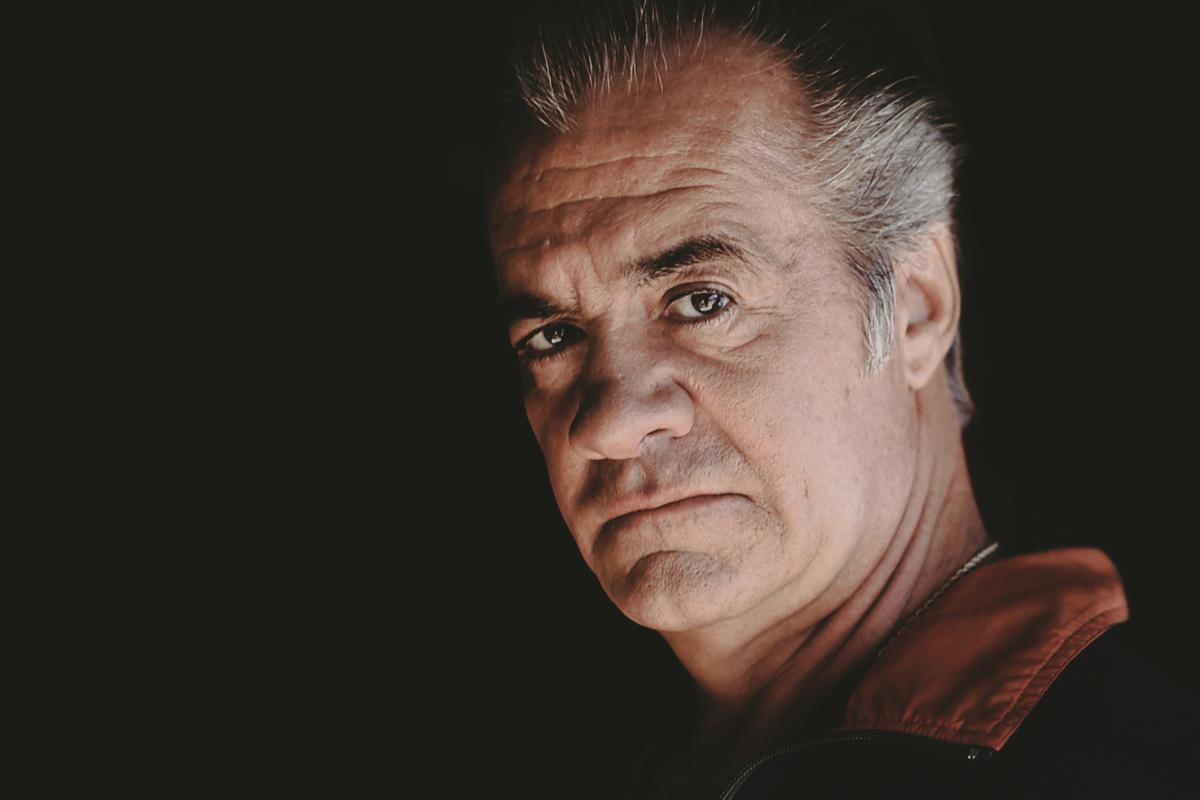
The first great moment of existentialism on The Sopranos comes not in Dr. Melfi’s office or by the pool as Tony looks for the ducks, but in Christopher Moltisanti’s dimly lit apartment.
The episode is “The Legend of Tennessee Moltisanti,” the one where Chrissy first catches the screenwriting bug. The young gangster is in his boxers and a Guinea tee, slumped over his laptop and surrounded by Bud Light cans. In comes Paulie “Walnuts” Gualtieri, the sharply dressed mob capo with winged hair a few decades wiser than Moltisanti. Paulie’s got a couple of girls waiting for them in the car, but Chrissy doesn’t want to go anywhere. He wants to talk about his purpose in life—his arc, to borrow a term from his movie-writing books.
See, a character like Keanu Reeves’s in The Devil’s Advocate has a clear arc. He has his triumphs and struggles. He changes and evolves and devolves and bounces back. Things are happening for him, or at least to him. But not so for Chrissy, who’s still trying to find his place in the world. “He starts down here, he ends up here,” he says, raising his hand to indicate Reeves’s character’s journey. “Where’s my arc, Paulie?”
What comes out of Paulie’s mouth would go down as one of the most quotable—and blunty profound—lines uttered on the most significant TV show of the past quarter-century.
“Hey, I got no arc either,” he quips back. “I was born, grew up, spent a few years in the Army, a few more in the can. And here I am, a half-a-wiseguy. So what?”
The dialogue resonates for many reasons: the ennui in Chrissy’s voice, the dichotomy between old school and new school, how it came to exemplify one of the HBO series’ defining relationships. But it also has an autobiographical bent. If anyone has ever credibly described themselves as a half-a-wiseguy, it’s the actor behind Paulie Walnuts, Tony Sirico, who died Friday weeks shy of his 80th birthday. Maybe Sirico didn’t have the Godfather car horn, and he almost certainly never lost his shoe in the snowy woods while hunting a Russian gangster, but there’s a lot of Paulie in Tony’s backstory.
Born in 1940s Brooklyn, Gennaro Anthony Sirico Jr. was raised in the tough East Flatbush and Bensonhurst neighborhoods. One of his brothers became a priest. Another became a stockbroker. Sirico chose a different path: low-level crime. That was partly out of necessity, he said. “In our neighborhood,” he once told a reporter, “if you weren’t carrying a gun, it was like you were the rabbit during rabbit-hunting season.” Armed robberies became his speciality, but he also roughed up bookies and engaged in the street violence that defined New York at the time. Sirico was reportedly an associate of the Colombo crime family during its wars of the 1960s and ’70s. (Though, as he said in a 1989 documentary, he never killed anyone. When asked if he would right now for a million dollars, Sirico said no. “I don’t need the money,” he deadpanned.)
Perhaps it was an early sign of his acting prowess, but despite 28 arrests on his record, Sirico was convicted only twice. One of those prison stints—in the infamous Sing Sing—proved to be fateful. While Sirico served time on an armed-robbery conviction, a traveling troupe of felons-turned-actors named the Theater of the Forgotten visited the prison. (Think Bob Hope, but for thieves and gangsters instead of Army troops.) Sirico loved it. He also instantly thought he could put his classic good looks and chiseled biceps to use. After his release, he called an actor friend, who helped land him a role in the 1974 film Crazy Joe—naturally about the famed Colombo family caporegime. Later that year, he appeared briefly in The Godfather: Part II. Emboldened, Sirico began focusing on acting, taking classes and honing his craft. But more so than helping him with any scene work, he credited those sessions with changing who he was as a person. Most notably, that came when an early teacher leaned in and whispered to him mid-class, “Tony, leave the gun at home.”
“After so many years of packing a gun, I didn’t even realize I had it with me in acting class,” Sirico told the New York Daily News in 1999. “But when he told me to leave the gun home, he meant for me to also leave my former life behind, to be an actor.”
He’d get steady work, though he was often typecast, playing some version of the tough-guy Italian. Sirico’s most memorable pre-Sopranos role came in Goodfellas, when he shoved Henry Hill’s mailman into a pizza oven head-first. (Close runner-up for his best part: this early ’90s Dunkin’ Donuts commercial.) He became a recurring actor in Woody Allen’s stable in the 1990s, appearing as a boxing trainer in Mighty Aphrodite and a gangster in Bullets Over Broadway. He’d later pop up in Cop Land and the 1996 Armand Assante version of Gotti, and while he played police officers in Dead Presidents and Allen’s Deconstructing Harry, he saw it all as cut from the same cloth. “I’ve done like 45 movies, played 40 gangsters and five crooked cops,” he told the Daily News. Not that he complained. He was proud to be part of the collective known as the “Gangster Actors Guild,” a group of performers who showed up at every casting call looking for people with tough-guy faces and vowels at the end of their last name.
That unofficial fraternity brought Sirico to The Sopranos—which, it should be noted, didn’t arrive as a prestige-TV deal, but rather as a quirky dart throw by a network best known at the time for Arli$$ and Real Sex. He initially auditioned for the role of Uncle Junior, but he was too young. The Coke-bottle glasses would eventually land on the face of Dominic Chianese, 12 years Sirico’s senior and himself a veteran of the second Godfather. Sirico would get a collection of colorful tracksuits, which he wore like plates of armor. Instead of Uncle June, Sopranos creator David Chase found him what was supposed to be a smaller role: Dimeo crime family captain Paulie “Walnuts” Gualitieri, who got his nickname by hijacking a truck he thought was full of TVs only to find it was transporting, well, walnuts. Sirico had just one line in the series’ pilot. (“You gotta say to yourself, ‘It could have been worse,’” he tells Artie, who’s still reeling from the Vesuvio’s arson job.) But Chase soon realized that in Sirico, he had someone who could be both comic relief and a menacing figure. To evoke one of the show’s most quotable malapropisms, Paulie came to represent the sacred and the propane.
How else do you explain a character who was deeply beloved in spite of—or maybe partly because of—all the heinous things he did? He smothered his ma’s frenemy for a few thousand bucks, but he teared up when he heard his song, “Nancy (With the Laughing Face).” (Why the fuck was that his song?) He killed Mikey Palmice in the woods, the whole time freaking out about poison ivy. He had a pristine collection of identical white shoes and liked satin finish on his nails, but when the boss needed someone to suss out Big Pussy’s allegiances, he called on his longtime enforcer. Paulie briefly flirted with jumping the New Jersey ship for New York’s, but a few episodes later, he was hanging a (slightly modified) painting of his leader on his wall. He was a crook through and through who ran the Feast of St. Elzéar as he would a sportsbook, but he also clipped coupons after a big heist. He beat cancer. He learned his ma wasn’t his ma, but rather his aunt. He saw the Virgin Mary in the Bada Bing. A noted germaphobe, he hated the thought of shoelaces dragging in the piss on the men’s room floor. (Women’s toilets, however, you could eat maple ice cream out of.) He couldn’t pronounce Sun Tzu or Baja Fresh. At a fancy dinner in Italy, he just wanted some macaroni and gravy. He may have had the highest body count on The Sopranos—truly saying something given the world he inhabited—but he was also the most consistently funny character, and perhaps its most iconic short of Tony Soprano himself. Paulie’s mortal sins were forgivable, even if they would mean a little detour on the way to paradise on the back end.
And the hair—it’s impossible to discuss Paulie and Tony Sirico without discussing the streaks of silver on either side of his head. They looked like a goose spreading its wings against a pitch-black night, or from a distance, a shiny Cadillac convertible. They harken back to a bygone era of dapper mafiosos, even if you’ve never seen anything quite like them before. (Aside from maybe Grandpa Munster or Sirico’s favorite actor, James Cagney.) They signified both class and a slight ridiculousness, and they’re partly why the comedy of the show’s most memorable episode, “Pine Barrens,” cuts so deep: After a tortured night eating relish and discussing interior decorating, Paulie stumbles through the labyrinthian woods alongside Chrissy. Typically prim and proper and dressed impeccably, Paulie looks downright haggard, his normally slicked-back hair sticking up in every direction, as though he just shoved a Smith & Wesson in an electrical outlet.
But that hairdo also signified the connection between Paulie and the man playing him. Where most of the other actors on The Sopranos dressed nothing like their characters, Sirico’s wardrobe could’ve doubled as Paulie’s. He was practically his own stylist, and that included what adorned his head, which no one on set was allowed to touch. On the Talking Sopranos podcast, Bobby Bacala actor Steve Schirripa said that Sirico would go to a barbershop in Brooklyn to dye his hair jet black. He’d then add the silver wings afterward. Before episodes, he would style himself, spending hours with a comb and Aqua Net hairspray. It was just one example of the many that highlighted the razor-thin differences between the real person and the fictional invention. “There was an episode where they were going to Paulie’s apartment, and the set designers and producers were racking their brains to figure out what the apartment would look like,” Schirripa said. “They were going on and on. ‘What would Paulie’s apartment look like?’ Finally, somebody said, ‘The guy is the guy. Let’s go to Tony Sirico’s apartment.’ That wound up being Paulie Walnuts’s apartment.”
The resemblances also went beyond just the clothes and furniture, and into his personality. Cast members remember getting a rise out of Sirico by saying something about Cagney (a supremely Paulie proposition)—or, in the case of Robert Iler, who played A.J. Soprano, Sirico showing up at his confirmation in a double-breasted pinstripe suit, handing him an envelope full of cash, and saying, “You ever have any problems, you call Uncle Tony.” Sometimes, the similarities worked to the detriment of the show’s crew, like when he didn’t like the pillows at the hotel he stayed at while filming “Pine Barrens” outside of New York City. As The Ringer’s Alan Siegel reported in his excellent oral history of the episode, Sirico sent an assistant to his home in Brooklyn to fetch Sirico’s pillows. It took him about four hours to get there and back. The assistant probably wasn’t happy, but two decades later, it makes for a great story. “There’s a very, very thin line between Paulie and Tony Sirico,” Sopranos writer Terrence Winter told Siegel. Sirico seemed to agree: “When I look in the mirror in the morning, I don’t know if I’m lookin’ at Tony or Paulie,” he said ahead of the show’s fourth season. “We got cross-pollinated.”
That small distinction makes Sirico getting his due even sweeter. While much of the credit for The Sopranos’ world-building goes to Chase and his writing team, it’s impossible to imagine anyone being able to capture Paulie Walnuts quite like Sirico. The way he held out his pointer and pinky fingers, his face flipping from warm smile to murderous mean mug in a moment’s notice, how he’d howl, “Whaddya hear, whaddya say”—all went into making Paulie one of the most indelible characters of 21st-century television. (As actor Billy Magnussen found out when he revived the role for the Sopranos prequel film, The Many Saints of Newark, a lot more goes into playing Paulie than just getting the hair right.) Even after the series cut to black in June 2007, the legend of Tony Sirico endured. His most notable post-Sopranos role came as a mobbed-up dog on Family Guy, but he appeared in dozens of other shows and films. There are also traces of him in tattoos and T-shirts, and in the cologne he launched a few years back.
Sure, a lot of that’s a testament to his singular character, but Sirico deserves a commendatori for splitting from Paulie in one significant way. Paulie was the most comfortable, least ambitious snake in the Sopranos universe—able to survive many wars not because of any particular guile or skill, but because he knew how to stay in his lane. Sirico the man did the precise opposite, leaving the gun at home and changing the course of his life in the process. As a result, he did what was seemingly impossible 50 years ago, when he was sitting in Sing Sing, or even when he was first cast in the show: He went from mobster to mob-flick royalty.
There’s no purer distillation of that transformation than the scene at SopranosCon, a 2019 festival of gaudiness celebrating the show’s legacy and even included a sprawling, maze-like homage to “Pine Barrens.” Among the dozens of booths of Sopranos actors both major and bit, none attracted a longer line than Sirico’s, with people waiting hours for a chance at an autograph or picture with Paulie. Seventy-seven at the time, Sirico needed a golf cart to get around the Meadowlands Exposition Center. He spent most of his time in a backroom, and after he emerged midway through SopranosCon’s first day, he needed to tap out early. As his driver began to maneuver through the crowd, the sea of tracksuits and hoop earrings parted, with many onlookers beaming with delight or sticking out their pointers and pinkies in salute. It was a fitting tribute to a loyal soldier—one who lived through a few years in the can, only to discover that maybe he did indeed have an arc.
Not a bad second act for a half-a-wiseguy.

